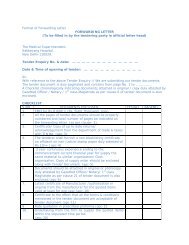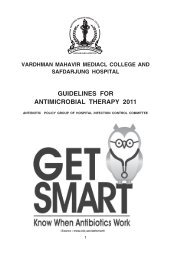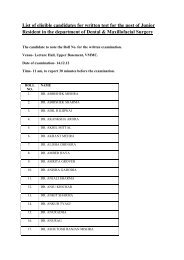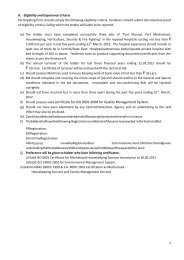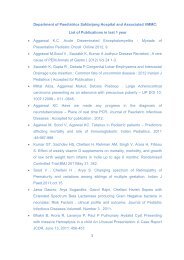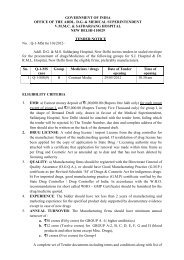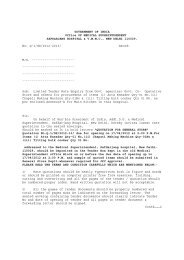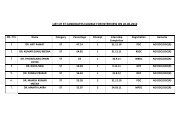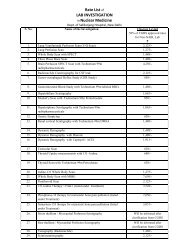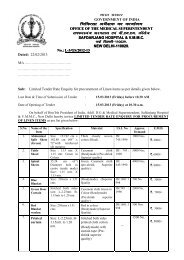Guidelines for INFECTION CONTROL POLICY - Safdarjung Hospital
Guidelines for INFECTION CONTROL POLICY - Safdarjung Hospital
Guidelines for INFECTION CONTROL POLICY - Safdarjung Hospital
Create successful ePaper yourself
Turn your PDF publications into a flip-book with our unique Google optimized e-Paper software.
Microbiological StudyMicrobiological study is planned depending upon the known epidemiology of the infectionproblem. The study is carried out to identify possible sources and routes of transmission.The investigation may include cultures from other body sites of the patient, other patients, staffand environment. Careful selection of specimens to be cultured is essential to obtain meaningfuldata.Specific control measuresSpecific control measures are instituted on the basis of nature of agent and characteristics ofthe high-risk group and the possible sources. These measures may include :• Identification and elimination of the contaminated product• Modification of nursing procedures• Identification and treatment of carriers• Rectification of lapse in clinical technique or procedureEvaluation of efficacy of control measures• The efficacy of control measures should be evaluated by a continued follow-up of casesafter the outbreak, clinically as well as microbiologically. Control measures are effectiveif cases cease to occur or return to the endemic level.The outbreak will be documented and the records should be kept with HICC and should bepresented in HICC meeting.ANTIMICROBIAL <strong>POLICY</strong>The annual antibiogram is released from the microbiology department. Antibiotic susceptibilitytests is analyzed regularly on a quarterly basis and the common resistance patterns of thebacterial isolates are reported and discussed in the HICC meetings and the antibiotic policy isreviewed accordingly. Present Antibiotic policy is published as separate documentAntibiotic policy is prepared in consultation with respective clinical departmentsAntibiotic policy shall be prepared using following general principles:1. Data is analyzed on a quarterly basis as per hospital records)(a) Common etiological agents as per(i) site of infection(ii) age groups(iii) patient location – outdoor (OPD), indoor (wards & critical care areas)(b) Antibiogram data as per(i) site of infection(ii) age groups(iii) patient location – outdoor (OPD), indoor (wards & critical care areas)(c) Unusually resistant organisms to be confirmed and submitted <strong>for</strong> further characterizationto National Centre <strong>for</strong> Disease Control (NCDC) <strong>for</strong>2. Standard treatment guidelines [categorization of patients as per age and Communityacquired infections (CAI) / Health care associated infections (HCAI)](a) <strong>Guidelines</strong> <strong>for</strong> empirical antimicrobial therapy as per common clinical syndrome(i) Adults & older children1. Blood Stream Infections (BSI)2. Meningitis3. UTI15



